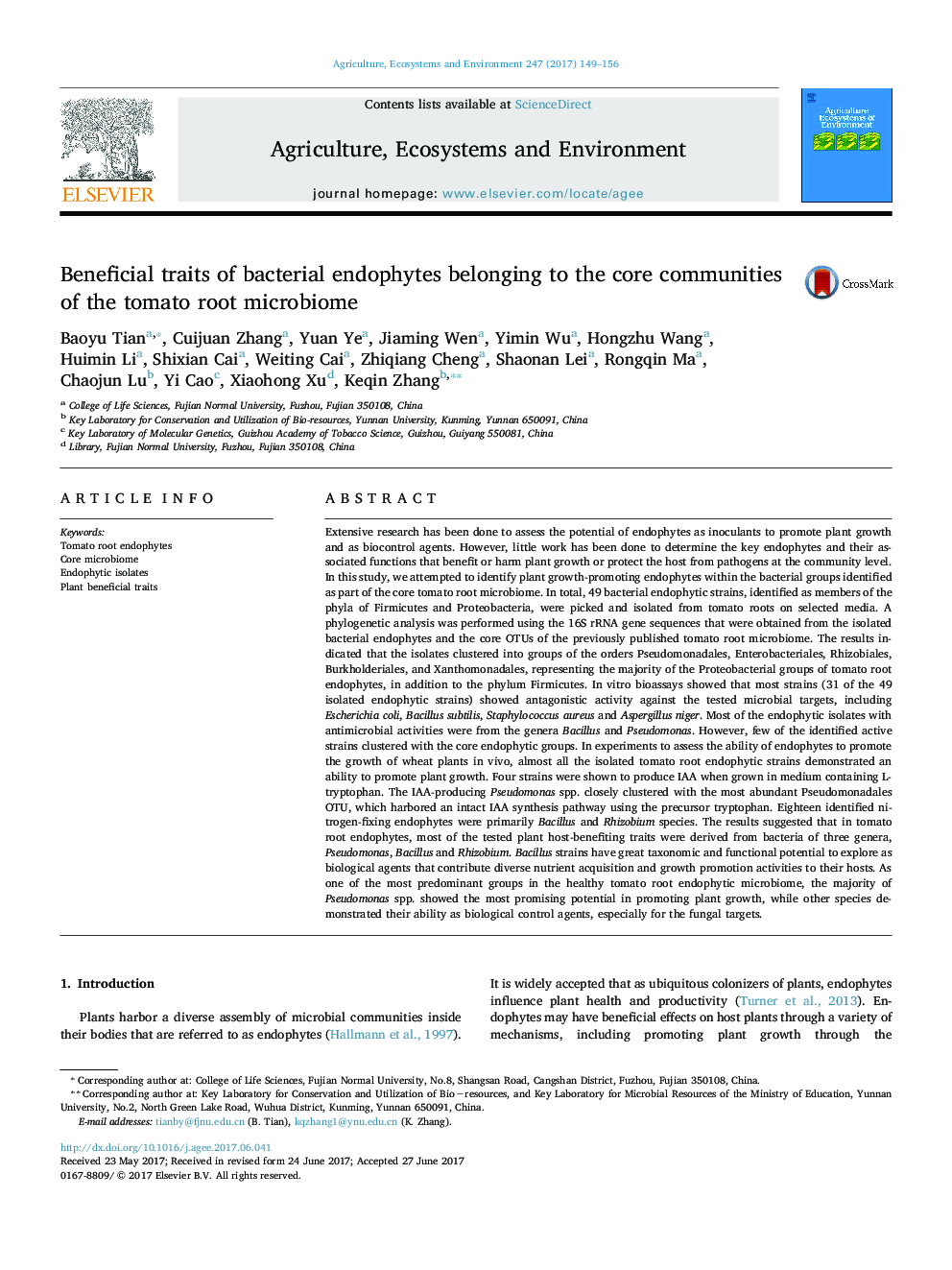| کد مقاله | کد نشریه | سال انتشار | مقاله انگلیسی | نسخه تمام متن |
|---|---|---|---|---|
| 5537987 | 1552005 | 2017 | 8 صفحه PDF | دانلود رایگان |
عنوان انگلیسی مقاله ISI
Beneficial traits of bacterial endophytes belonging to the core communities of the tomato root microbiome
ترجمه فارسی عنوان
صفات مفید از اندوفیت های باکتریایی متعلق به جوامع اصلی از میکروبیوم ریشه گوجه فرنگی است
دانلود مقاله + سفارش ترجمه
دانلود مقاله ISI انگلیسی
رایگان برای ایرانیان
کلمات کلیدی
اندوفیت ریشه گوجه فرنگی، میکروبیوم هسته، جدایی اندوفیتی، ویژگی های گیاهی سودمند،
موضوعات مرتبط
علوم زیستی و بیوفناوری
علوم کشاورزی و بیولوژیک
علوم زراعت و اصلاح نباتات
چکیده انگلیسی
Extensive research has been done to assess the potential of endophytes as inoculants to promote plant growth and as biocontrol agents. However, little work has been done to determine the key endophytes and their associated functions that benefit or harm plant growth or protect the host from pathogens at the community level. In this study, we attempted to identify plant growth-promoting endophytes within the bacterial groups identified as part of the core tomato root microbiome. In total, 49 bacterial endophytic strains, identified as members of the phyla of Firmicutes and Proteobacteria, were picked and isolated from tomato roots on selected media. A phylogenetic analysis was performed using the 16S rRNA gene sequences that were obtained from the isolated bacterial endophytes and the core OTUs of the previously published tomato root microbiome. The results indicated that the isolates clustered into groups of the orders Pseudomonadales, Enterobacteriales, Rhizobiales, Burkholderiales, and Xanthomonadales, representing the majority of the Proteobacterial groups of tomato root endophytes, in addition to the phylum Firmicutes. In vitro bioassays showed that most strains (31 of the 49 isolated endophytic strains) showed antagonistic activity against the tested microbial targets, including Escherichia coli, Bacillus subtilis, Staphylococcus aureus and Aspergillus niger. Most of the endophytic isolates with antimicrobial activities were from the genera Bacillus and Pseudomonas. However, few of the identified active strains clustered with the core endophytic groups. In experiments to assess the ability of endophytes to promote the growth of wheat plants in vivo, almost all the isolated tomato root endophytic strains demonstrated an ability to promote plant growth. Four strains were shown to produce IAA when grown in medium containing L-tryptophan. The IAA-producing Pseudomonas spp. closely clustered with the most abundant Pseudomonadales OTU, which harbored an intact IAA synthesis pathway using the precursor tryptophan. Eighteen identified nitrogen-fixing endophytes were primarily Bacillus and Rhizobium species. The results suggested that in tomato root endophytes, most of the tested plant host-benefiting traits were derived from bacteria of three genera, Pseudomonas, Bacillus and Rhizobium. Bacillus strains have great taxonomic and functional potential to explore as biological agents that contribute diverse nutrient acquisition and growth promotion activities to their hosts. As one of the most predominant groups in the healthy tomato root endophytic microbiome, the majority of Pseudomonas spp. showed the most promising potential in promoting plant growth, while other species demonstrated their ability as biological control agents, especially for the fungal targets.
ناشر
Database: Elsevier - ScienceDirect (ساینس دایرکت)
Journal: Agriculture, Ecosystems & Environment - Volume 247, 1 September 2017, Pages 149-156
Journal: Agriculture, Ecosystems & Environment - Volume 247, 1 September 2017, Pages 149-156
نویسندگان
Baoyu Tian, Cuijuan Zhang, Yuan Ye, Jiaming Wen, Yimin Wu, Hongzhu Wang, Huimin Li, Shixian Cai, Weiting Cai, Zhiqiang Cheng, Shaonan Lei, Rongqin Ma, Chaojun Lu, Yi Cao, Xiaohong Xu, Keqin Zhang,
